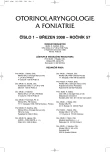Evaluation of Hearing and Speech Treatment by Means of Phonological Awareness Test and Dichotic Tests
Authors:
O. Dlouhá; E. Škodová
Authors‘ workplace:
Foniatrická klinika 1. LF UK a VFN, Praha
přednostka doc. MUDr. O. Dlouhá, CSc.
Published in:
Otorinolaryngol Foniatr, 57, 2008, No. 1, pp. 16-21.
Category:
Original Article
Overview
At the heart of SLI (specific language impairment) there is a disorder of auditory perception. In speech perception in children with SLI temporal processing there is one of the functions necessary for the discrimination of phonemes and of similar words. The existence of cognitive function disorders is much more important than those directly involved in the speech production . Our group of children with SLI was repeatedly tested during speech and hearing treatment by means of phonological awareness and of dichotic tests.
1. The phonological awareness was tried by pairs of words that are similar or differ on one phonem (the words were chosen according to distinctive features of sounds of Czech language). In comparison with results of children of appropriate age, SLI children have disturbed ability to differentiate phonemes.
2. Using central auditory dichotic tests we analysed integration receptive problems in children with SLI. Two-syllable words were presented simultaneously to both ears, the children had to repeat all together. The average number of correct responses was significantly lower in SLI children than in children from control group.
Special hearing and speech treatment can improve auditory and auditory-related skills to create long-term benefit for children with SLI. In comparison and evaluation of results of both tests during our therapy we confirmed good success in word recognition, in phonological analysis and in central auditory function.
Key words:
phonological awareness, dichotic listening, specific language impairment
Sources
1. Bellis, T. J.: Assessment and management of central auditory processing disorders in the educational setting. Singular Publishing Group, Inc. 1996, 359 s.
2. Bellis, T. J., Willer, L. A.: Effects of aging and gender on interhemisphere function. JSLHR, 4, 2001, s. 246-263.
3. Bishop, D. V. M.: Uncommon understanding. East Sussex: Psychology Press, 1999, 277 s.
4. Delb, W., D. J. Strauss,G. Hohenberg, P. K. Plinkert: The binaural interaction komponent (BIC) in children with central auditory processing disorders (CAPD). Int. J. Audio, 42, 2003, s. 401-412.
5. Dlouhá, O.: Centrální porucha sluchu u dětí s vývojovou dysfázií. Otorinolaryng. a Foniat. /Prague/, 54, 2005, 1, s. 32-35.
6. Dlouha, O.: A longitudinal study of children with specific language impairment (SLI). Aktuelle phoniatrisch-paedaudiologische Aspekte, 2005. Band 13, s. 63-66.
7. Dlouha, O.: Central auditory processing disorder (CAPD) in children with specific language impairment (SLI). Int. J. of Ped. Otorhinolaryng, 71, 2007, s. 903-907.
8. Ferre, J. M.: Understanding childrenś central auditory disorders. Abstracts, 25th World Cogress of the International Association of Logopedics and Phoniatrics. Montreal, 2001, 366 s.
9. Hess, M. M.: Central auditory processing disorder. HNO, 49, 2001, 8, s. 593-597.
10. Chermak, G. D., Musiek, F.: Central auditory processing disorders. (New perspectives) Singular Publishing Group, Inc. San Diego. London, 1997, 374 s.
11. Iliadou, V., Iakovides, S.: Contribution of psychoacoustics and neuroaudiology in revealing correlation of mental disorders with central auditory processing disorders, Ann. Gen. Psychiatry, 2, 2003, 5 s.
12. Kuhn-Inacker, H., Weinmann, S.: Training the temporal order perception – A concept of supporting the language perception of children with central auditory processing disorders (CAPD). Sprache-Stimme-Gehor, 24, 2000, s. 119-125.
13. Kupka, K.: Statistická analýza výsledků vyšetření fonematického sluchu u předškolních dětí (1988-1989). Trilobyte, Statistical Software, Ltd. Pardubice, 1993, 36 s.
14. Novák, A.: Audiologie. Praha, 2003, 333 s.
15. Smith, M. D., Damico, J.: Childhood language disorders. Thieme, N. York, 1996, 330 s.
16. Shriberg, L. D., Austin, D., Lewis, B. A., McSweeny, J. L. Wilson D. L.: The speech disorders classification system (SDCS). Extensions and Lifespan reference data, JSLHR, 40 1997, s. 723-740.
17. Škodová, E., Michek, F., Moravcová, M.: Hodnocení fonematického sluchu u předškolních dětí. Otorinolaryngol., 43, 1994, 4, s. 236-239.
18. Škodová, E.: Zkušenosti s využitím standardního testu „Hodnocení fonematického sluchu u předškolních dětí“ v diagnostice a terapii. EFETA, XI, 2001, 4, s. 19-24.
19. Tallal, P., Stark, R. E.: Speech acoustic-cue discrimination abilities of normally developing and language-impaired children. Journal of the Acoustical Society of America, 69, 1981, s. 568-574.
Labels
Audiology Paediatric ENT ENT (Otorhinolaryngology)Article was published in
Otorhinolaryngology and Phoniatrics

2008 Issue 1
Most read in this issue
- Evaluation of Hearing and Speech Treatment by Means of Phonological Awareness Test and Dichotic Tests
- Defensins – an Important Component of Natural Immunity in Defense against Infection
- Evaluation of Dysphagia, Treatment Possibilities of the Patient with Dysphagia at the ENT Departments in the Czech and Slovak Republics
- Cleft Defects and Their Role in the Origin of Chronic Otitis in Older Children and Adolescents
